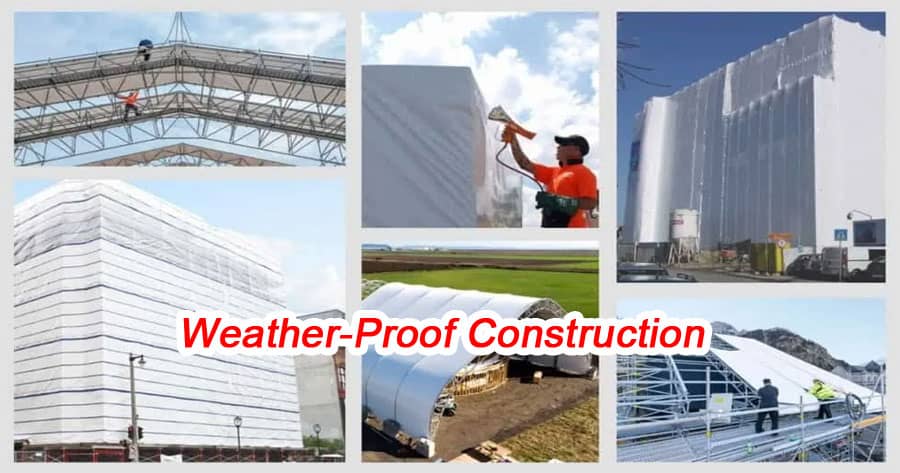Building for Climate Resilience: Techniques for Weather-Proof Construction

In the face of escalating climate change, weather-proof construction has emerged as a critical aspect of sustainable building practices. As we witness increasing instances of extreme weather events, it becomes imperative for builders, architects, and homeowners to adopt climate-resilient construction techniques.
Understanding Climate Resilience in Construction
Climate resilience in construction refers to the ability of a building to endure and recover from extreme weather events such as hurricanes, floods, heatwaves, and cold snaps. The primary goal is to minimize damage, ensure occupant safety, and maintain functionality during and after such events. This involves integrating advanced building technologies, using durable materials, and implementing design strategies that enhance the structural integrity of buildings.
Choosing the Right Materials for Weather-Proof Construction
1. High-Performance Insulation
Effective insulation is a cornerstone of climate-resilient buildings. High-performance insulation materials such as spray foam, rigid foam boards, and fiberglass significantly reduce heat transfer, thereby maintaining consistent indoor temperatures. This not only enhances energy efficiency but also protects the building from extreme temperature fluctuations, which can cause structural damage over time.
2. Impact-Resistant Roofing
Roofs are the first line of defense against weather extremes. Using impact-resistant roofing materials such as metal, slate, or specialized shingles can prevent damage from hail, high winds, and heavy rains. These materials are designed to withstand severe impacts, reducing the likelihood of leaks and structural damage.
3. Durable Siding and Exterior Materials
The exterior of a building is continuously exposed to harsh weather conditions. Selecting durable siding materials like fiber cement, brick, or engineered wood ensures long-lasting protection against moisture, wind, and UV rays. These materials not only enhance the building's aesthetic appeal but also offer superior resistance to decay and weathering.
Advanced Structural Design Techniques
1. Elevation and Floodproofing
In flood-prone areas, elevating buildings above the base flood elevation is crucial. This can be achieved through stilts, raised foundations, or even floating structures. Additionally, incorporating floodproofing measures such as waterproof barriers and drainage systems can protect the building's foundation and lower levels from water damage.
2. Wind-Resistant Design
Wind-resistant design is essential in hurricane-prone regions. This involves using reinforced concrete, steel frames, and hurricane straps to secure the roof and walls. The building's shape and orientation can also be optimized to reduce wind pressure. Features such as aerodynamic roofs and reinforced window systems can significantly enhance a building's resilience to strong winds.
3. Seismic Resilience
In areas prone to earthquakes, seismic design considerations are vital. This includes using flexible building materials, reinforcing structural elements, and installing base isolators to absorb seismic energy. Proper seismic design not only protects the structure but also ensures the safety of its occupants during an earthquake.
Energy Efficiency and Sustainability
1. Green Roofing Systems
Green roofs provide insulation, reduce stormwater runoff, and mitigate the urban heat island effect. By incorporating vegetation and specialized soil layers, green roofs can absorb excess rainwater and provide natural cooling. This not only extends the lifespan of the roof but also contributes to the building's overall energy efficiency.
2. Solar Panels and Renewable Energy Integration
Integrating solar panels and other renewable energy systems into the building design can significantly reduce dependence on non-renewable energy sources. Solar panels can be installed on rooftops or integrated into the building's facade, providing a sustainable energy solution that complements weather-proof construction.
3. Water Management Systems
Effective water management is essential for climate-resilient buildings. This includes the installation of rainwater harvesting systems, permeable pavements, and efficient drainage systems. By managing water resources efficiently, buildings can reduce the risk of flooding and water damage while conserving water for future use.
Innovative Technologies in Weather-Proof Construction
1. Smart Building Systems
Smart building systems leverage IoT (Internet of Things) technologies to monitor and control various building functions. This includes climate control, energy usage, and security systems. By using sensors and automation, smart systems can optimize the building's response to weather conditions, enhancing both resilience and energy efficiency.
2. Advanced Window Technologies
Windows are critical components in maintaining a building's energy efficiency and comfort. Advanced window technologies, such as low-E (low emissivity) glass and triple glazing, reduce heat transfer and provide better insulation. Additionally, impact-resistant windows with specialized coatings can protect against UV rays and extreme weather conditions.
3. Sustainable Building Materials
The use of sustainable building materials is an essential aspect of climate-resilient construction. Materials such as recycled steel, reclaimed wood, and bamboo offer durability and reduce the environmental impact of construction. These materials are not only eco-friendly but also provide excellent resistance to weather-related wear and tear.
Conclusion
Building for climate resilience is not just about protecting structures from extreme weather events; it is also about creating sustainable, energy-efficient, and comfortable living spaces. By integrating advanced materials, innovative design techniques, and smart technologies, we can construct buildings that withstand the challenges posed by climate change. Investing in weather-proof construction today ensures safer, more sustainable communities for the future.
